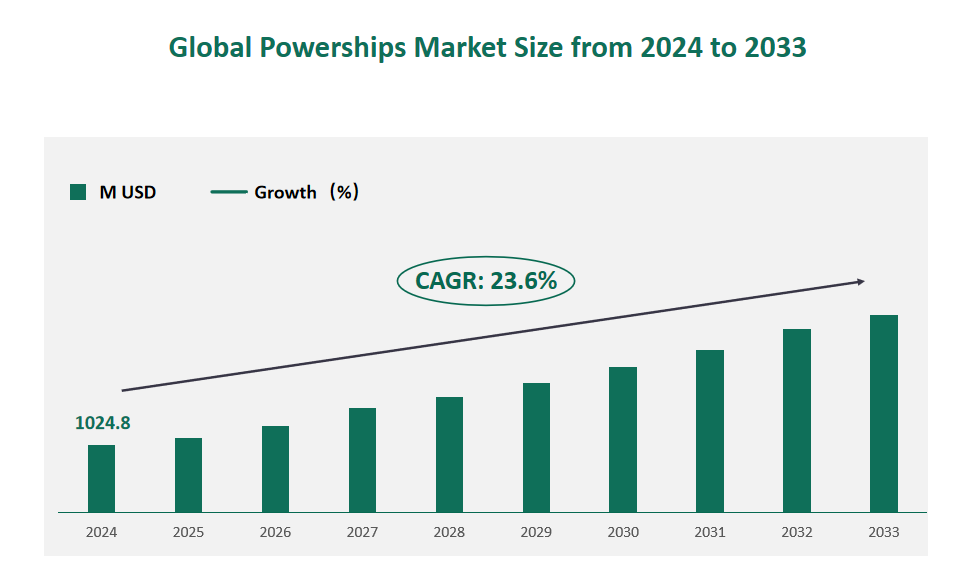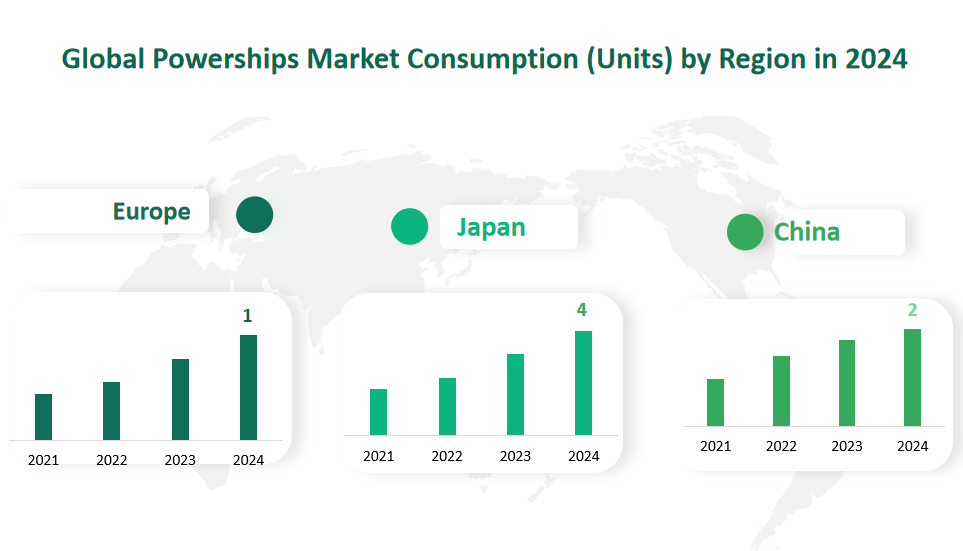1 Global Powerships Market Size (Value) and CAGR (2024-2033)
In 2024, the global Powerships market was valued at USD 1024.8 million, with a CAGR of 23.6% from 2024 to 2033.
A power ship is an existing ship that has been modified for power generation, a marine vessel, on which a power plant is installed to serve as a power generation resource.
Figure Global Powerships Market Size (M USD) and CAGR 2024-2033

2 Powerships Market Drivers
Growing Energy Demand
One of the primary drivers of the Powerships market is the increasing global demand for energy. As economies grow and industrialization accelerates, the need for reliable and flexible power solutions becomes more critical. Powerships offer a unique advantage in this context, as they can be quickly deployed to regions experiencing power shortages or lacking sufficient energy infrastructure. This is particularly relevant in emerging economies where the demand for electricity is outpacing the development of traditional power grids.
Natural Gas Production Boom
The significant increase in natural gas production, especially in regions like the United States and the Middle East, is another key driver. Natural gas is a cleaner and more efficient fuel compared to traditional fossil fuels, making it an attractive option for power generation. Powerships, with their ability to use natural gas, are well-positioned to capitalize on this trend. The growth in natural gas production is expected to continue, further fueling the demand for Powerships capable of utilizing this abundant resource.
Infrastructure Development in Emerging Markets
The Asia-Pacific region, with its rapidly growing economies like China and India, is witnessing substantial infrastructure development. The increasing number of connected electronic devices, the electrification of transportation and heating industries, and widespread digitalization are driving electricity consumption in these countries. Powerships can play a crucial role in meeting this surge in demand by providing flexible and mobile power solutions.
3 Powerships Market Restraints
High Maintenance Costs
One of the most significant challenges is the high maintenance cost associated with Powerships. These floating power plants are exposed to harsh marine environments, which can lead to wear and tear and potential damage to equipment. Maintenance of Powerships is often more complex and expensive compared to traditional land-based power plants.
Regulatory and Environmental Concerns
The operation of Powerships is subject to strict regulatory and environmental standards. Compliance with these regulations can be challenging and costly, particularly in regions with stringent environmental policies. Issues related to emissions, waste management, and the potential impact on marine ecosystems need to be carefully managed. Non-compliance can result in fines and operational disruptions, adding to the overall challenges faced by the industry.
Market Competition
The Powerships market faces competition from traditional land-based power plants and other alternative energy sources. The initial investment required for Powerships is relatively high, and they may not always be the most cost-effective solution compared to established power generation methods.
4 Global Powerships Market Size and Share by Type in 2024
Oil-fired Powerships are floating power plants that utilize oil as their primary fuel source. These ships are equipped with diesel engines or turbines that burn oil to generate electricity. They offer flexibility in fuel usage and can operate in regions where oil is readily available. Oil-fired Powerships are particularly useful in areas with high oil production or where oil is a more cost-effective fuel option.
In 2024, the revenue generated by oil-fired Powerships is projected to be approximately 137.5 million US dollars (M USD). This segment accounts for about 13.42% of the total market revenue. The growth of oil-fired Powerships is driven by the need for reliable power solutions in regions with limited access to natural gas infrastructure. These ships are often deployed in remote areas or developing countries where infrastructure for other fuels is not well-developed.
On the other hand, Gas-fired Powerships are floating power plants that use natural gas as their primary fuel source. These ships are equipped with gas turbines or engines that burn natural gas to generate electricity. Gas-fired Powerships are known for their efficiency and lower emissions compared to oil-fired units. In 2024, the revenue generated by gas-fired Powerships is projected to be approximately 887.3 million US dollars (M USD). This segment dominates the market, accounting for about 86.58% of the total market revenue. The significant increase in natural gas production, especially in regions like the United States and the Middle East, has driven the growth of gas-fired Powerships.
Table Global Powerships Market Size and Share by Type in 2024
Type | Market Size (M USD) 2024 | Market Share 2024 |
Oil-fired Powership | 137.5 | 13.42% |
Gas-fired Powership | 887.3 | 86.58% |
5 Global Powerships Market Consumption by Application in 2024
Military Applications: Powerships play a crucial role in providing reliable and flexible power solutions for military operations. In 2024, the military sector is expected to consume 8 units of Powerships. This high consumption is driven by the need for robust and mobile power generation capabilities, especially in regions with limited infrastructure or during emergency situations. Powerships are particularly valuable for military use due to their ability to be quickly deployed and relocated as needed. They provide essential power support for military bases, field operations, and other defense-related activities.
Table Global Powerships Market Consumption (Units) by Application in 2024
Application | Market Consumption (Units) 2024 |
Military | 8 |
6 Global Powerships Market Consumption by Region in 2024
Europe: Europe is expected to produce 1 unit of Powerships in 2024. The region’s market dynamics are influenced by its focus on renewable energy and environmental regulations. While the production volume is relatively low, Europe remains a significant player in the Powerships market due to its advanced technological capabilities and demand for flexible power solutions. Powerships in Europe are often used in coastal areas with high energy demands or during periods of grid instability.
Japan: Japan is projected to produce 4 units of Powerships in 2024. The country’s market dynamics are driven by its need for reliable power solutions following the Fukushima disaster, which highlighted the vulnerabilities of traditional nuclear power plants. Powerships offer a flexible and mobile alternative, particularly for regions with high seismic activity or limited land availability for large-scale power plants. Japan’s advanced technological infrastructure and focus on innovation also support the growth of the Powerships market.
China: China is expected to produce 2 units of Powerships in 2024. The country’s rapid industrialization and urbanization have led to a significant increase in electricity demand. Powerships can provide temporary and flexible power solutions to meet peak demand periods or support regions with insufficient grid infrastructure. China’s strategic focus on developing its maritime capabilities also supports the growth of the Powerships market.
Figure Global Powerships Market Consumption by Region in 2024

7 Major Players in Global Powerships Market
7.1 Karpowership
Company Profile
Karpowership is a renowned company in the Powerships industry, known for its innovative and flexible power generation solutions. Established in 1948, Karpowership has a long history of providing reliable and efficient energy services. The company’s headquarters are located in Turkey, with its primary production sites situated in the Middle East. Karpowership operates in multiple regions, including Africa, America, Asia, Europe, and the Middle East, showcasing its global reach and influence. The company is part of the Karadeniz Energy Group, a conglomerate with diverse interests in the energy sector.
Business Overview
Karpowership specializes in building, owning, and operating floating power plants, known as Powerships. These vessels are designed to meet the energy needs of various regions, particularly those with inadequate infrastructure or during periods of peak demand. Karpowership’s fleet includes some of the largest and most advanced floating power plants in the world, such as the Khan Class and Shark Class Powerships. The company’s business model focuses on providing flexible and mobile power solutions that can be quickly deployed to meet urgent energy needs. Karpowership’s services are particularly valuable in regions prone to power outages or with limited access to traditional power grids.
Product Introduction
Karpowership offers a range of Powerships, each designed to meet specific energy requirements. The Khan Class Powerships are among the largest in the world, with a capacity of 415–470 MW. These vessels are 285–300 meters long and 45–50 meters wide, featuring a draft of 5–7 meters. They are equipped with advanced technology, including dual-fuel engines, onboard high-voltage substations, and fuel storage facilities. The Shark Class Powerships, on the other hand, have a maximum capacity of 240 MW. These vessels are 160–240 meters long and 20–32 meters wide, with a draft of 5–6 meters. They are designed with the highest technology, offering dual-fuel engines and onboard accommodations for crew members.
Recent Financial Performance
In the most recent year, Karpowership has demonstrated strong financial performance, reflecting its market leadership and operational efficiency. The company’s revenue for the year was approximately 228.4 million US dollars (M USD), showcasing its significant market share and robust business operations. Karpowership’s gross margin for the year was 21.79%, indicating a healthy profitability level despite the challenges posed by the global economic environment and industry-specific factors such as maintenance costs and regulatory compliance.

